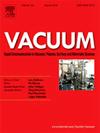Investigating the tribological behavior of bioinspired surfaces in agro-waste and alumina reinforced AA6063 matrix composites
IF 3.8
2区 材料科学
Q2 MATERIALS SCIENCE, MULTIDISCIPLINARY
引用次数: 0
Abstract
The tribological behavior of three bioinspired (BI) agro-waste ashes—bean pod ash (BPA), cassava peel ash (CPA), and coconut husk ash (CHA)—integrated as reinforcements in an alumina-reinforced AA6063 matrix hybrid and monolithic composite was investigated. Studies utilizing agro-wastes for bioinspired surfaces are limited despite these wastes posing significant environmental challenges. Consequently, there has been a growing effort to valorize these residues for sustainable engineering applications. This study uses a two-step stir-casting methodology to engineer bioinspired materials with lightweight properties, exceptional hardness, and wear-resistant characteristics. Microstructural investigations revealed a homogeneous distribution of natural and synthetic reinforcements within the AA6063 matrix. Lightweight AMCs were successfully fabricated, exhibiting densities ranging from 2.57 to 2.74 g/cm³ and hardness values between 81.28 and 107.47 BHN. The average surface roughness of these composites varied from 2.4 to 3.4 μm, with ANOVA tests confirming a statistically significant difference (p < 0.005). Wear rates and the coefficient of friction were observed to range from 2.52 x 10−3 to 5.50 x 10−3 mm³/m and 0.2476 to 0.5403, respectively. Reinforcing the AA6063 alloy with bioinspired agro-wastes significantly enhanced the hardness and tribological performance of the as-cast BI-AMCs. Notably, the wear rates and friction coefficients were significantly reduced, with the monolithic BI-AMCs demonstrating superior results. Furthermore, adding bioinspired agro-wastes, such as BPA, CPA, and CHA, improved the surface texture of AA6063 more effectively than Al2O3, leading to slightly smoother surfaces. These nuanced bioinspired tribological behaviors present opportunities for tailored load-bearing and aesthetic applications derived from agro-waste-based composites. This study advances our understanding of bioinspired tribological phenomena and paves the way for the development of innovative materials with diverse applications and enhanced performance.
研究农业废弃物和氧化铝增强 AA6063 基复合材料中生物启发表面的摩擦学行为
研究了三种生物启发(BI)农业废弃物灰烬--豆荚灰(BPA)、木薯皮灰(CPA)和椰子壳灰(CHA)--的摩擦学行为,这些灰烬作为增强材料被集成到氧化铝增强 AA6063 基质混合和整体复合材料中。利用农业废弃物制作生物启发表面的研究十分有限,尽管这些废弃物对环境构成了重大挑战。因此,越来越多的人开始努力将这些残留物用于可持续工程应用。本研究采用两步搅拌铸造法,设计出具有轻质特性、超强硬度和耐磨特性的生物启发材料。微结构研究表明,天然和合成增强材料在 AA6063 基体中分布均匀。成功制造出的轻质 AMC 密度介于 2.57 至 2.74 g/cm³ 之间,硬度值介于 81.28 至 107.47 BHN 之间。这些复合材料的平均表面粗糙度从 2.4 到 3.4 μm 不等,方差分析测试证实其差异具有统计学意义(p < 0.005)。磨损率和摩擦系数分别为 2.52 x 10-3 至 5.50 x 10-3 mm³/m 和 0.2476 至 0.5403。用生物农作物废弃物强化 AA6063 合金可显著提高铸造 BI-AMC 的硬度和摩擦学性能。值得注意的是,磨损率和摩擦系数明显降低,单片 BI-AMC 的效果更佳。此外,与 Al2O3 相比,添加双酚 A、CPA 和 CHA 等生物农产废料能更有效地改善 AA6063 的表面纹理,使其表面略微光滑。这些细微的生物启发摩擦学行为为基于农业废弃物的复合材料提供了量身定制的承重和美学应用机会。这项研究加深了我们对生物启发摩擦学现象的理解,为开发具有多样化应用和更高性能的创新材料铺平了道路。
本文章由计算机程序翻译,如有差异,请以英文原文为准。
求助全文
约1分钟内获得全文
求助全文
来源期刊

Vacuum
工程技术-材料科学:综合
CiteScore
6.80
自引率
17.50%
发文量
0
审稿时长
34 days
期刊介绍:
Vacuum is an international rapid publications journal with a focus on short communication. All papers are peer-reviewed, with the review process for short communication geared towards very fast turnaround times. The journal also published full research papers, thematic issues and selected papers from leading conferences.
A report in Vacuum should represent a major advance in an area that involves a controlled environment at pressures of one atmosphere or below.
The scope of the journal includes:
1. Vacuum; original developments in vacuum pumping and instrumentation, vacuum measurement, vacuum gas dynamics, gas-surface interactions, surface treatment for UHV applications and low outgassing, vacuum melting, sintering, and vacuum metrology. Technology and solutions for large-scale facilities (e.g., particle accelerators and fusion devices). New instrumentation ( e.g., detectors and electron microscopes).
2. Plasma science; advances in PVD, CVD, plasma-assisted CVD, ion sources, deposition processes and analysis.
3. Surface science; surface engineering, surface chemistry, surface analysis, crystal growth, ion-surface interactions and etching, nanometer-scale processing, surface modification.
4. Materials science; novel functional or structural materials. Metals, ceramics, and polymers. Experiments, simulations, and modelling for understanding structure-property relationships. Thin films and coatings. Nanostructures and ion implantation.
 求助内容:
求助内容: 应助结果提醒方式:
应助结果提醒方式:


